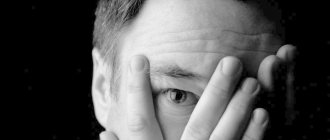Arachnophobia
- obsessive fear of spiders and similar insects. Translated from Greek it means “spider + fear”.
It should be noted that most people are afraid of spiders. But obsessive fear of arachnids is distinguished by signs characteristic of diseases - it changes behavior.
The arachnophobe not only avoids places where arthropod insects could theoretically appear, but also avoids their images, strives to destroy them at the first sight, constantly waits for their appearance, and ensures that the floors, walls and ceilings are kept absolutely clean.
Symptoms of arachnophobia
In most cases, arachnophobia is mild.
, causing you to feel fear only at the sight of spiders, which is relatively rare. Such people usually do not seek help from specialists, since the quality of life, in general, is not impaired due to this.
With
average severity of obsessive fears of spiders,
the condition is more severe and brings daily suffering. Thoughts about meeting spiders become literally constant companions, accompanied by an influx of vivid ideas and fantasies with unpleasant and creepy images of arachnid creatures.
Severe arachnophobia
manifested by severe panic attacks, autonomic disorders in the form of trembling, palpitations, shortness of breath and a feeling of lack of air, gastrointestinal disorders (constipation, diarrhea), increased sweating. Sleep and appetite are disturbed, the patient has great difficulty leaving his home.
Unlike most other phobias, individuals with arachnophobia do not recognize that the fear has no objective cause and is completely irrational. This is due to the fact that most adults (especially women) are squeamish about spiders, considering them creepy and scary-looking.
Let's talk about phobia
The word “phobia” recently entered our lexicon. Many people today are not just afraid, they “suffer from phobias,” using this phrase to designate all their fears and experiences.
The more complex the world, the more fears there are. Some are afraid of earthquakes and natural disasters, others are afraid of the dark and dogs, others are afraid of heights and crowded places.
I wonder how a phobia arises and how to find a way to get rid of obsessive fears. We addressed similar questions to Olga Sharypova, a teacher and psychologist at the medical prevention office of the Khanty-Mansiysk Clinical Psychoneurological Dispensary.
- What is a phobia? Is this a mental disorder or a type of fear?
— A phobia is the fear of something that does not exist in reality. In other words, this is a symptom, the essence of which is irrational uncontrollable fear or a persistent experience of excessive anxiety in certain situations or in the presence (expectation) of an object. In psychiatry, a phobia is usually called a pathologically increased manifestation of the fear reaction to a particular stimulus. Phobias have traditionally been considered within the framework of obsessive-compulsive disorders related to thinking disorders.
A phobia is a strongly expressed, obsessive fear that irreversibly worsens in certain situations and cannot be fully explained logically.
As a result of the development of a phobia, a person begins to fear and therefore avoid certain objects, activities or situations. Phobias or obsessive fears are anxiety disorders and are acquired fears.
— How to distinguish between fear and phobia?
— Fears and phobias are very close, but there are significant differences between them. What distinguishes a phobia from ordinary fear is, first of all, its senselessness, and it is difficult to control by consciousness and common sense. Fear is a natural protective function of the body in the face of real danger. Fear is an emotion that arises in situations of threat to the biological or social existence of an individual.
— Are there reasons for the occurrence of a phobia?
— The cause of a phobia is fears that arise during some unpleasant situations, for example, in adult life. Another reason for the occurrence of a phobia can be called the experiences that a person had to experience in childhood. It is childhood experiences (psychological trauma, severe stress) that are retained very vividly in our memory. Therefore, at certain moments in life, children's fears simply begin to emerge in memory and develop even more. Almost every person has something to remember from their childhood. Many people are afraid of heights, darkness, and loneliness because they experienced some terrible event in childhood.
People who are emotional and very sensitive, that is, people with certain personal characteristics, are most often susceptible to fears. It is worth emphasizing that it is people with an insufficiently stable psyche who are most prone to the formation and development of a phobia. Phobias can appear in people with a rich imagination, since it is quite difficult for them to distinguish between real and imaginary danger. It is much more difficult for them to resist this negative feeling than for people with a more stable and strong psyche. People who are subject to such fear are actually afraid of something that is not there. After all, a phobia is the fear of fear itself. A person is simply afraid to be afraid.
—What are phobias? Which ones are the most common?
— In the literature you can find various classifications of phobias; summarizing all the theoretical and practical material, we can distinguish several groups of phobias:
The first of these includes fear of space, manifested in various forms. Perhaps the most widely known of this series is claustrophobia - the fear of enclosed spaces. However, the opposite phenomenon also happens - some people are terrified of open spaces. In its severe form, this disease is agoraphobia.
The second group of phobias includes the so-called social phobias associated with social life. They include ereitophobia (fear of blushing in front of people), fear of public speaking, and fear of not being able to perform any action in the presence of strangers. Social phobias include the fear of public speaking, which is very common among people, and the fear of meeting a girl you like on the street. Another fear, as if adjacent to the one indicated above, is the fear of “losing” a loved one. This fear, as a rule, is based on deep-seated self-doubt or low self-esteem, as well as past negative experiences in this area. In other words, a person who has already been left by a loved one (or loved one) will expect a repetition of a similar scenario.
The third group includes nosophobia - fears of contracting some disease. This type of obsessive fear is always present in society to one degree or another, but is particularly aggravated and becomes widespread during epidemics.
The fourth group of obsessive fears includes thanatophobia - fear of death.
The fifth group includes various sexual fears, phobias associated with intimate life, for example, coitophobia - fear of sexual intercourse.
The sixth group includes fears of harming oneself or loved ones, the seventh group includes “contrasting” phobias, for example, the fear of loudly uttering obscene words in society. And finally, the eighth group of fears is phobophobia or, in other words, fear of being afraid of something. For example, specific phobias are fear of a specific object (fear of lightning, water, storms, fear of snakes, rodents, spiders, etc.).
And from an everyday point of view, all fears can be divided into three parts depending on age.
- Childhood fears. Every child experiences fear of the negative characters of the fairy tale - Baba Yaga, Koshchei the Immortal, Barmaley. Many children have a common fear - the fear of the dark, of little drums, and so on. Of course, all these nightmares and fears pass in most cases.
— Teenage fears. As you know, a person’s personality is just being formed during puberty. Almost all teenagers have an unstable nervous system. During adolescence, a large flow of information is directed at minors: homework, relationships with the opposite sex, socialization. The most common fears in adolescence are tanaphobia, the fear of death, and intimophobia, the fear of relationships with the opposite sex. And all these fears also pass quickly. But, if some fear remains from childhood or adolescence, then it should not be treated as a lifelong diagnosis; it is very important to eradicate it.
- Parental fears. Almost all parents are subject to a wide variety of fears associated with their child - this is the fear that the child will get lost or be stolen. In young families, there is a panicky fear of responsibility.
Thus, the most popular phobias are social (fear of speaking in public), acrophobia (fear of heights), cynophobia (fear of dogs), aviophobia (fear of flying), astralophobia (fear of thunderstorms), nyctophobia (fear of the dark), agoraphobia (fear of open spaces). spaces), claustrophobia (fear of small spaces), arachnophobia (fear of spiders), dentophobia (fear of going to the dentist).
— What should a person do if his usual fear has already turned into a phobia and interferes with his normal life?
— Phobias seriously complicate a person’s life. They interfere with adaptation in society, make self-development impossible, and sometimes lead to the fact that a person generally loses the opportunity to leave the house. A psychotherapist treats phobias. A specialist will help you find the true cause of your fears and teach you how to deal with them effectively. The best “cure” for a phobia is working with the subconscious using cognitive behavioral therapy and various neuro-linguistic programming (NLP) techniques. To work with a phobia, you can use six-step reframing, the method of visual-kinesthetic dissociation, etc. The main desire of the person himself.
Take care of yourself! And remember that life is not given to live in fear.
Natalya Tetenok
Photo by Ilya Yurukin
article from the site https://cmphmao.ru/node/8764
Treatment of arachnophobia
The main techniques that have a therapeutic effect on the obsessive fear of spiders:
- Psychotherapy.
- Pharmacotherapy.
- Physiotherapy.
- Biofeedback therapy.
- Reflexology.
- General restorative methods: massage, manual therapy, physical therapy, yoga.
Most often, treatment is limited to psychotherapeutic assistance, but in some cases other methods mentioned above are added to it.
In the overwhelming majority of cases, arachnophobia is completely reversible, especially if a specialist was consulted in the early and unexpressed stages of the development of this painful condition.
How to distinguish a phobia from “simple” fear
Let's look at the difference between fear and phobia using a real example.
There are a sufficient number of people who are afraid to travel in the subway. If the cause of fear is fear, it must be caused by certain negative experiences in the past. For example, a person once felt ill on the subway. If the reason is fear, then the person will prefer to move around the city by ground transport, but if the need arises, he will still go down to the metro. Naturally, this will be accompanied by certain experiences, but will be controlled by common sense and logical thinking. In the case of a phobia, the problems will be much more significant, depending on the severity of the phobia. In the mildest cases, a person will still go down to the subway, but any, even the most insignificant, stops of the car between stations will cause a pre-panic and panic state. In the most severe cases, a person will not be able to force himself to go down to the subway even in case of emergency, contrary to logic and common sense, and any attempts to force this by other people can cause severe psychological trauma. Is this relevant? According to world statistics, every eighth inhabitant of planet Earth has phobias. Thus, phobias, as a type of neurotic disorders (Neuroses, depression, fears) are a widespread phenomenon.
Causes of fear of spiders
Arachnophobia is a disease that does not develop in a vacuum.
Psychologists say that arachnophobia can develop for the following reasons:
- There is an opinion that aversion to spiders is Consequence of evolutionary development
. The concern dates back to the days when a bite was most likely to lead to death. During the period of the plague, spiders were considered one of the carriers of infection.At the same time, some uncivilized peoples do not have any aversion to arthropods as such - they are eaten.
- A child can copy the behavior of adults
. When a child sees his parents panic when a spider appears, the idea is reinforced in his mind that he is dangerous and should be watched out for. Therefore, most people acquire a phobia in childhood, and find it difficult to say exactly at what point it was formed. - Anxiety can develop due to watching a feature film or documentary
in which the hero is seriously injured or died from an arthropod bite. - Fear is often provoked by the fact that arthropods have the ability to move quickly and appear suddenly.
Each of us has at least once found a spider in our home unexpectedly - for example, in a dark corner in the bathroom. In addition, all arachnophobes consider these insects extremely unattractive and disgusting. Mainly, the large number of legs in spiders causes disgust.
Types of phobias. Classification of phobias
Currently, more than 500 types of phobias have been described. The most common of these are social phobia and agoraphobia.
- Social phobia is a type of phobia that is characterized by a pronounced fear of being the center of attention of strangers, or of behaving in a way that will cause humiliation or embarrassment. This type of phobia manifests itself in social everyday situations - during a meeting with friends, lunch in a cafe, the need to speak at a meeting, and others.
- Agoraphobia is a type of phobia associated with “helplessness if things suddenly become bad.” This type of phobia manifests itself in the fear of traveling unaccompanied or being among strangers.
All other types of phobias are classified into the group of so-called isolated phobias.
Below are examples of just a few of them. Phobias of animals or insects:
- - cynophobia - fear of dogs;
- - Gatophobia - fear of cats;
- - arachnophobia - fear of spiders;
- - ophidophobia - fear of snakes.
Phobias associated with situations:
- - claustrophobia - fear of closed spaces;
- - ochlophobia - fear of crowded places;
- - monophobia - fear of being alone with oneself;
- - xenophobia - fear of foreigners, strangers.
Phobias associated with natural forces:
- - acrophobia - fear of heights;
- - nyctophobia - fear of darkness, night;
- - aquaphobia - fear of water;
- - pyrophobia - fear of fire;
- - thalassophobia - fear of the sea.
Health-related phobias:
- — odontophobia – fear of dental treatment;
- - bacillophobia - fear of microorganisms;
- - Cardiophobia - fear of cardiovascular diseases;
- - Hematophobia - fear of the sight of blood.
Phobias associated with conditions and actions:
- - stasibasiphobia - fear of an upright position and walking;
- - stasyphobia - fear of standing;
- - lalophobia - fear of speaking;
- - tremophobia - fear of trembling;
- - Basilophobia - fear of walking;
- - amaxophobia - fear of traveling in public transport.
Phobias associated with objects:
- - hyalophobia - fear of glass;
- - macrophobia - fear of large objects;
- - microphobia - fear of small objects;
- - computerphobia - fear of computers;
- - Belonephobia - fear of piercing objects.
Contact a specialist
Sign up for a consultation tel. 242-82-65
Make an appointment
Yuri Lvovich Muchnik
Psychiatrist-narcologist
Doctor of the highest category. 35 years of experience. Works at the Clinic named after. prof. F.F. Preobrazhensky since 2001
Popular questions and answers
Can a phobia lead to disability and is it acceptable to treat it with traditional methods? Psychotherapist Sergei Prokin answered these and other questions .
Are there possible complications of this phobia, does it affect the ability to work, does it threaten disability or death?
Fear of spiders will not lead to death or disability. But such a phobia can have social consequences - it is difficult for a person to work or live in houses or premises where insects may live. Even the smallest and most harmless spiders provoke attacks of severe fear and extremely unpleasant sensations. This threatens social isolation, constant problems at work and in the family.
Is it possible to cure yourself or with the help of unconventional methods (dietary supplements, herbs, acupuncture, hypnosis)?
Attempts at self-medication, especially with unconventional methods, various dietary supplements or herbs, and dubious methods can only worsen the situation. Without treatment from a doctor, the phobia can intensify, causing increasingly serious problems.
Set your goals in advance
Plan your actions when encountering insects in order from easiest to most difficult. For example, you would like to be able to independently expel unwanted insects outside the apartment. Your goals for the next couple of months might look like this:
- stay in the same room with the insect for 2–3 minutes;
- approach him at a distance of 2–3 meters;
- observe the insect from a distance of 1 meter for a couple of minutes;
- cover the insect with a jar (here you can start with a bucket glued to a two-meter stick - the main thing is that you feel relatively comfortable);
- move the insect, covered with a jar, onto a thick sheet of paper and throw it out the window.
Training
The training includes exercises aimed at combating arachnophobia. They can be performed under the supervision of specialists or at home. Let's take a closer look at how to get rid of arachnophobia yourself.
Exercise to distance yourself from fear
To suppress fear, you need to master relaxation techniques. The exercises involve complete detachment from the object of the phobia and denial of its significance for the individual. To do this, it is necessary to take into account the characteristics of the human psyche.
People suffering from a phobia of spiders are more afraid of spiders in their own apartment . Fear is often associated with embellishing reality for various reasons. A person can cope with arachnophobia by mentally shrinking an insect to a small point.
Exercise getting rid of your spider
A popular method of treating arachnophobia is a graphic image of an insect. A person who is afraid of spiders is asked to draw a large specimen on paper and destroy the drawing with his own hands.
After this, the individual needs to draw small individuals. Training therapy continues until the person gets rid of his fears.
How to stop being afraid on your own
There are psychological trainings that teach how to get rid of arachnophobia yourself. The most effective behavioral technique is to approach a person with an object of fear.
Habituation begins with small individuals and ends with large-sized exotic animals. Those individuals who can overcome their fear will forever get rid of arachnophobia.
Keeping a spider in your home and caring for it will help a person cope with the problem on his own. In this case, the body turns on the mechanics of overcompensation, which completely frees the subject from the negative feelings he had towards insects.
Another good way to independently suppress a phobia is computer games that simulate the behavior of fearful people in virtual reality. Scientists have proven that the effectiveness of computer games will increase by 2 times when a person touches the monitor with his hand.
What are the dangers of arachnophobia?
What is the fear of spiders (phobia) in terms of risk to health and life? Experts state that the disease is unsafe for humans. The main problem is panic without control. In this state, the individual tries to leave a dangerous situation as quickly as possible, without dismantling anything in his path. This is fraught with harm to the life or health of a person and others.
Important! Dangerous consequences include a constant state of stress. Arachnophobia becomes a part of a person’s life, along with an anxious expectation of a threat. On a subconscious level, the client is afraid of an unpleasant meeting all the time.
A phobia of spiders often leads to manic symptoms. For example, searching for accumulations of arthropods in order to destroy them, or a fanatical attitude towards cleanliness. It is most difficult for those people who live in regions with a southern climate, as well as those vacationing on hot continents. Neighborhood with insects is almost impossible to completely avoid. They often settle in dwellings and weave their webs in corners. Experts advise not to nurse your fears, but rather to start getting rid of them.
Prevention of arachnophobia in adults at home
Prevention of fear of spiders, as psychotherapist Sergei Prokin , like most other phobias, should begin in childhood. It includes various activities to strengthen physical and mental health, especially the functioning of the nervous system.
Equally important is the rational upbringing of children - without severe emotional stress, without the formation of constant anxiety, and avoiding overprotection. Parents should be involved in developing correct and age-appropriate social skills and independent decision-making.










